Owl Labs’ survey results from its 5th annual edition of the “State of Remote Work” report confirmed what we already knew: the state of remote work is permanent. Remote and hybrid work arrangements are cornerstones of The U.S. workforce. They not only helped U.S. workers remain productive during the COVID-19 pandemic but also serve as essential components for how employees imagine themselves working in a post-pandemic future.
Download a copy of “The Permanent State of Remote Work” report PDF.
If you are tired of conversations about remote work, then this is not the blog post for you. Since 1979, when five IBM employees were permitted to work from home in Silicon Valley, digitally-driven remote work has been part of the U.S. employment landscape.
Forty years later, the permanent state of remote work means it is no longer a novelty. Remote work is an expectation of the modern workplace, the need for which has been reinforced by the COVID-19 pandemic.
And Upwork predicts 36.2 million Americans will work from home by 2025.
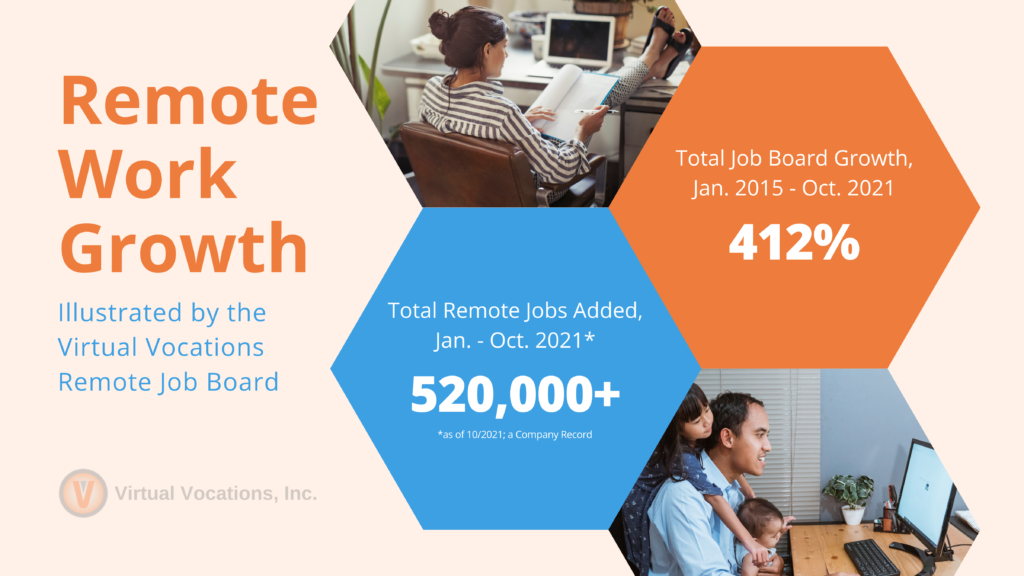
Remote Work Growth, by the Numbers
Virtual Vocations has documented remote work’s continued climb via our Remote Work Statistics and Data Analysis Reports. Through surveys and internal data analyzed and cataloged since 2015, we know that the increased availability of remote and hybrid work choices is significant.
Data from our November 2021 Remote Jobs Report, for example, highlights our latest company record: from January through October 2021, the Virtual Vocations team added more than 520,000 remote job openings to our Remote Jobs Database. Within this 10-month period, Virtual Vocations surpassed every previous year’s annual tally for total remote jobs added to the job board. The 2021 remote work boom accounts for 412% job board growth since January 2015.
Owl Labs Looks to the Future of Work
To gauge how the widespread persistence of remote and hybrid work affected U.S. employees in 2021, as well as what they desire for their professional futures, Owl Labs, a collaborative communication technology company specializing in immersive video experiences for businesses, polled 2,050 full-time U.S. workers on their opinions.
Prepared in conjunction with Global Workplace Analytics, the 5th annual Owl Labs “State of Remote Work” survey findings published exclusively to USA TODAY on November 11. The survey addressed the following subjects:
- How U.S. workers view hybrid and remote work arrangements,
- How employers are responding to increased demand for virtual and home-based job options, and
- How employee behaviors have changed since the onset of the COVID-19 pandemic.
Key Findings from the “State of Remote Work 2021”
Owl Labs collected survey answers during September 2021. Respondents, all of whom were between the ages of 21 and 65, were equally split among the ‘male’ and ‘female’ gender classifications. In addition, all respondents worked for companies with at least 10 employees, and most worked within one of the following career categories:
- Technology (13%)
- Healthcare (13%)
- Financial, Insurance, and Real Estate Services (13%)
- Other (12%)
- Education (9%)
- Manufacturing (8%)
- Retail (8%)
Additional findings relate to the future of hybrid and remote work, employee expectations, work-at-home realities, telecommuter demographics, remote work benefits, and the evolution of hybrid workplaces.
- 90% of employees who worked from home during the COVID-19 pandemic were at least as productive, if not more productive, compared to working in a physical office.
- 84% stated that continuing to work from home in a post-pandemic world would make them happier.
- 71% of employees want remote or hybrid work options to continue once the pandemic ends.
- Since gaining telecommuting experience during the pandemic, 64% of employees now prefer hybrid meetings.
- 63% of employees who worked remotely amid the COVID-19 pandemic also provided care for children or another dependent.
- Among workers who have returned to work in an on-site office at least one day per week, 57% stated they would prefer working remotely 100% of the time.
- 46% of U.S. employees would be willing to sacrifice 5% of their wages for the ability to work from home at least some of the time.
- Only 38% of employees reported that their employers have upgraded company video technologies to enable more efficient collaboration and virtual communication in a hybrid setting.
- Approximately 33% would quit their jobs if there were no post-pandemic remote work options available to them in their current roles.
- 25% of employees either changed jobs during the pandemic or were actively looking for new work opportunities; within this group, 90% said they want better career opportunities; meanwhile, 84% also want greater flexibility over where they work.
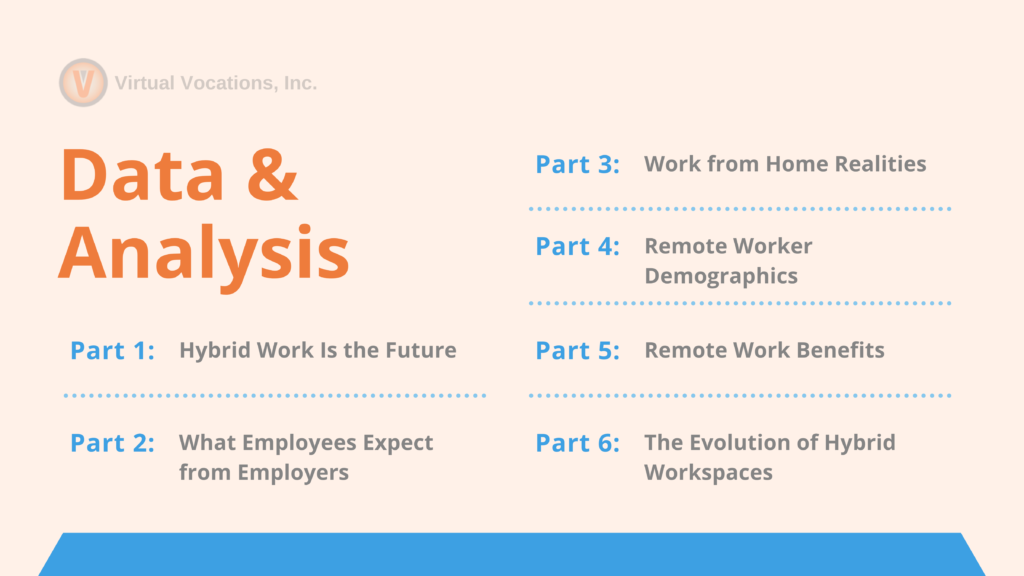
Analyzing the Permanent State of Remote Work
To analyze the permanent state of remote work, Virtual Vocations opted for a holistic approach. We referenced the latest Owl Labs report statistics as well as Virtual Vocations internal data and survey results to create a big-picture examination of how the workforce landscape may look in a post-pandemic world. This report is a data-driven look at the future of remote and hybrid work in the U.S.
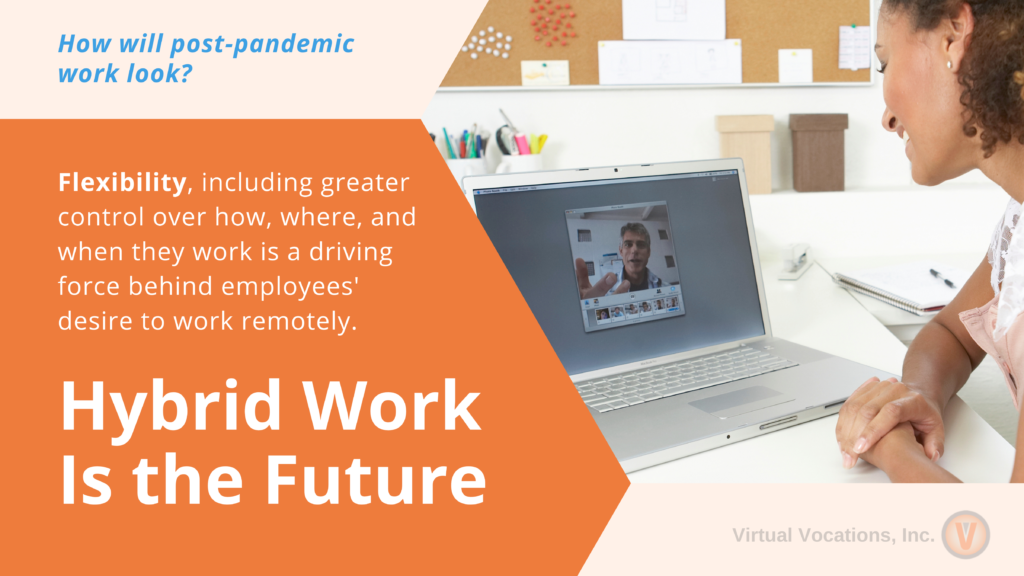
Hybrid Work Is the Future
The global pandemic transformed how we work overnight – and because of this, we’ve officially fast-tracked to the future of work.
Owl Labs, State of Remote Work 2021
More than 4 million U.S. workers quit their jobs in August of this year, but were remote job options a consideration employees weighed before handing in their notices and joining the Great Resignation?
In a word? Yes.
A scenario Owl Labs posed to full-time employees who worked from home during the pandemic demonstrated the value modern employees place on remote work. When polled about their hypothetical response to the suggestion that they could no longer work remotely, 32% said they would quit their jobs outright and 56% said they would quit or find new jobs offering flexibility.
Flexibility is a well-known word at Virtual Vocations. It is the driving force behind jobseekers’ motivations to find ways to work from home. Jobseekers consider remote work the best avenue to seize greater control over their lives and schedules. And since the pandemic began, flexibility through remote work has only grown in importance. Remote jobseekers are now using their core values to guide their job searches and looking for work that will allow them to put their personal relationships first.
Gain insight into employment trends to watch via this Phil La Duke interview with Virtual Vocations CEO Laura Spawn as they discuss “Preparing for the Future of Work.“

What Employees Expect from Employers
Do employees’ new expectations align with what employers are planning to offer post-pandemic? Not exactly.
Owl Labs, State of Remote Work 2021
Approaching work with a remote-first mentality is a must for employers in 2021 and beyond. While 73% of employees have returned to the office at least one day per week since the onset of the pandemic, according to Owl Labs, more than half (57%) admitted they prefer working remotely 100% of the time.
Employees’ preferred work environments and reported stress levels should matter to employers, especially where well-being is concerned amid a global pandemic. In the Virtual Vocations Remote Health and Wellness Survey, we asked 983 professionals about their opinions on wellness, health, and how those themes intersect with remote work. This is what we found:
- Workers feel that overall health, including both mental and physical well-being, contributes greatly to their professional success (78%).
- Working from home is considered the least stressful work arrangement (68%), compared to only 4% of professionals who feel the same way about working in a physical office.
- The primary cause of stress among remote workers and remote jobseekers is not enough social contact with others, which has been heightened during the pandemic.
- Lunch & Learn webinars and daily virtual coffee breaks are the most popular virtual employment perks.
- More than 42% of workers would like their employers to provide them with access to yoga, Pilates, or other exercise incentives, but only 6% of professionals said their current employers provide these options.
For inspiration on how to incorporate additional health perks into the remote workplace, check out Virtual Vocations’ guide to “4 Remote Employee Wellness Activities Employers Should Encourage Their Team to Do & Why.”

Work from Home Realities
Whether they are a parent, caretaker or pet owner, many employees have been challenged with fulfilling the needs of their employer with the needs of their families or households.
Owl Labs, State of Remote Work 2021
The realities of remote work are unique to every individual, but knowing hybrid and remote work trends can help employees and employers make better plans for their futures. Owl Labs identified environmental and household trends for employees who worked from home during the pandemic.
Here is a list of additional work from home realities for remote workers in the U.S.
- The most popular place to work from home during the pandemic was a dedicated home office (73%); meanwhile, 31% preferred coworking spaces and 24% enjoyed working outdoors.
- Most dependents cared for by teleworkers were children ages 11 to 18 (35%).
- Pets were popular pandemic-inspired household additions among remote workers. In fact, 51% adopted a pet, most of which were dogs, and 11% certified their pet as an emotional support companion.
- Moving was a practically universal trend during the pandemic, but permanent and temporary moves affected remote workers differently across generational lines. “Of those that worked from home during the pandemic, more than a quarter (27%) relocated during that time, with younger employees (ages 21-40) temporarily relocating 14X more than older ones (ages 40+).”
Parents need the flexibility to work and care for their children. For parents on the hunt for family-friendly jobs, Virtual Vocations’ list of “9 Remote Jobs for Parents with School-Aged Children” will get you started.
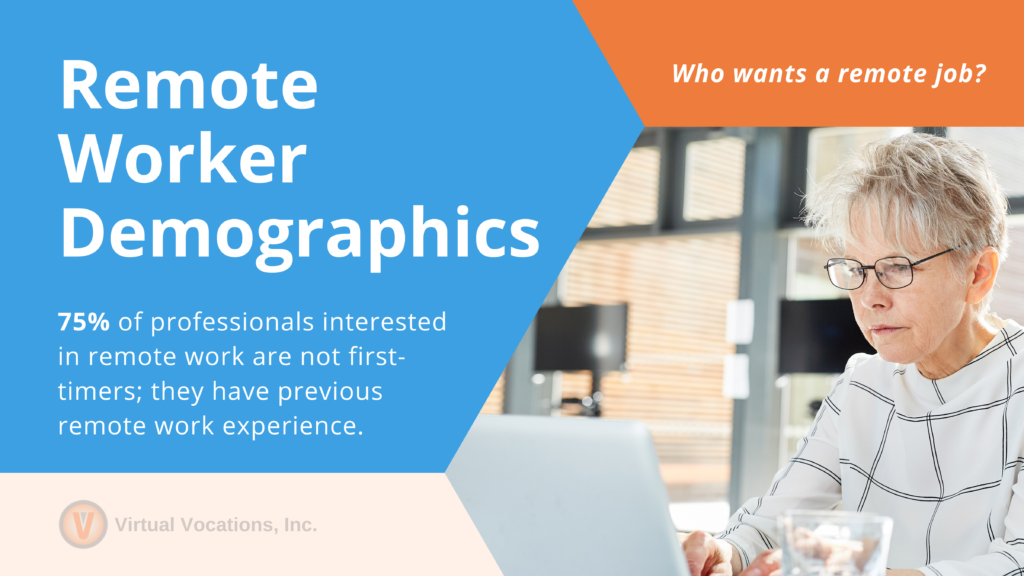
Remote Worker Demographics
For decades, employers have recognized that every employee operates differently…The pandemic threw some employers and employees for a loop, with many employees having to rethink their work routines and habits basically overnight. And some of these adjustments haven’t been easy. In fact, they’ve exposed some inequities between coworkers.
Owl Labs, State of Remote Work 2021
What kind of person wants to work remotely?
Throughout the years, Virtual Vocations has assisted more than four million jobseekers with finding and applying to remote jobs. Thanks to our member surveys and the thousands of remote workers and remote jobseekers who have responded to our polls, we can better understand the kind of person looking for remote work as well as how we can most effectively help them meet their career goals.
Most often, remote workers and remote jobseekers can be described in the following ways:
- They have previous telecommuting experience (75%).
- They are middle-aged professionals at least 45 years of age (72%).
- They are educated, with the majority holding at least a bachelor’s degree (70%).
- They are willing to change careers to work remotely (69%).
Owl Labs’ “State of Remote Work 2021” survey provided additional details concerning generational and gender factors that may influence remote work preferences and habits in the future. This is what Owl Labs discovered.
Generational variations showcase a wide variety of remote work lifestyles.
“Of the 73% of employees that have returned to the office at least one day a week: Millennials represent the largest percentage at 60%, compared to: 25% Gen X, 8% Boomers, and 7% Gen Z.”
While Boomers only accounted for 4% of employees who quit or decided to change roles, they were the largest group to move from a rural to an urban location during the pandemic (40%), as well as “the largest age group to move to another state (35%).” Millennials and Gen X-ers, however, packed their bags for an international journey, with 50% of Millennials and 33% of Gen X members opting to move to a different country.
Virtual Vocations survey data offers similar findings concerning the moving habits of Millennials and Baby Boomers. In our Generational Remote Work Statistics report, we found that 87% of of Millennials and 84% of Baby Boomers were interested in the digital nomad lifestyle. Digital nomads continuously work and travel, so remote work is popular with this professional demographic group.
Millennials and Baby Boomers were similarly minded in other areas as well. For example, 98.6% of Millennials and Baby Boomers overwhelmingly felt that remote work options should be standard job benefits for any company with positions conducive to working remotely.
Virtual team building helps bridge generational gaps among remote team members. If your distributed team needs help connecting, read this Virtual Vocations blog guest post on “The Benefits of Virtual Team Building in 2021.”
Remote work does not solve all gender inequalities.
Alternatively, when women work from home, they are more likely than men to continue working the same number of hours as they would if they worked from a physical office.
Talking of physical offices, when Owl Labs asked men about what reaction they would have if they were told they could no longer work remotely, 34% more men than women stated they would expect a salary increase to compensate for the deficit in remote work options. But men also have more favorable opinions toward on-site work in general.
When it came to being back in the office following the start of the COVID-19 pandemic, men enjoyed returning to the physical office 24% more than women. Men also claimed to enjoy their commutes to work 55% more than female workers.
Could remote work alleviate societal pressure for women to continue filling traditional, household gender roles when they work from home? Consider remote work’s impact on the gender chore gap in Virtual Vocations’ examination of the “Gender Chore Gap and Telecommuting: Does Working Remotely Close It?“
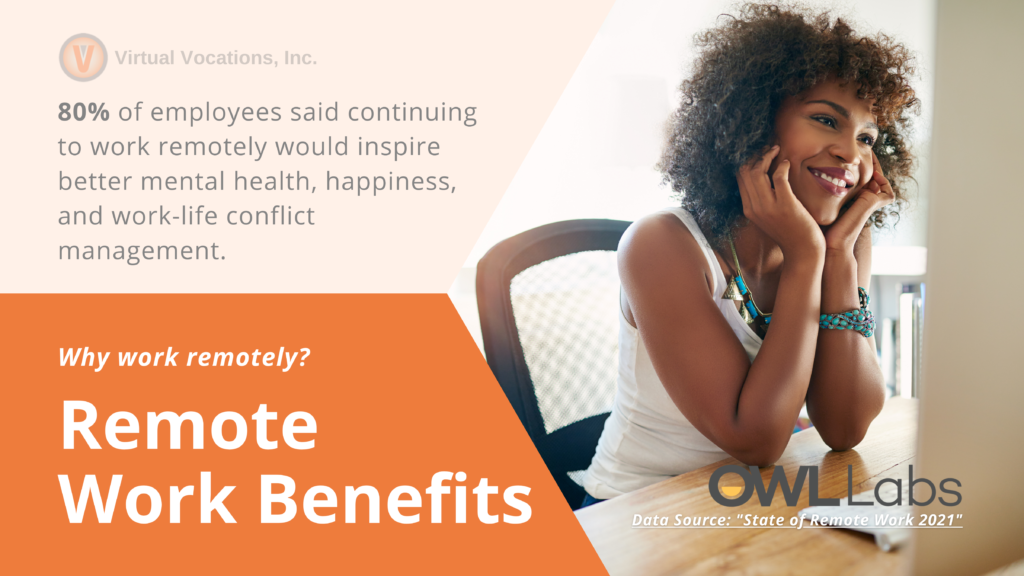
Remote Work Benefits
For many, transitioning to remote work started with setting up a dedicated workspace, learning new virtual collaboration tools, and adapting to new ways of engaging with colleagues and clients virtually. But that was all temporary, right? Not so much.
Owl Labs, State of Remote Work 2021
Employees and employers benefit from remote work.
During the COVID-19 pandemic, U.S. workers formed highly favorable opinions of remote work. When asked what continuing to work remotely at least some of the time in a post-pandemic world would contribute to their lives, the results were clear: better quality of life and work.
More than 80% of respondents believed continued remote or hybrid job options would inspire improved mental health and happiness as well as better work-life conflict management. But the top remote work benefit (86%) respondents imagined they would experience by continuing to work from home is the ability to be more present with their families and better able to support them.
Employers can reap the remote work benefits benefits, too. Even with a part-time remote work arrangement, 75% of employees stated they would be less likely to leave their companies and 78% “would be more likely to recommend their company.”
Learn the many ways remote work can change employees’ lives with Virtual Vocations’ examination of “Why Employees Want the Remote Work Lifestyle.”
Productivity is not hindered by remote work, but at what cost?
Employees feel differently.
Those who worked remotely during the pandemic reported high levels of productivity. Nearly 70% said that working from home led to increased productivity, and only 1% felt much less productive while telecommuting as opposed to working on-site.
More managerial attention, however, should be directed toward reducing remote work burnout. Only 11% of managers cite concerns over job fatigue among their remote employees, yet U.S. employees who work from home tend to work longer hours. According to Owl Labs, 55% of U.S. employees said they work longer hours at home than they do at the office.
Discover ways to curb work from home burnout while remaining productive with Virtual Vocations’ “10 Tips to Prevent Work from Home Burnout.”
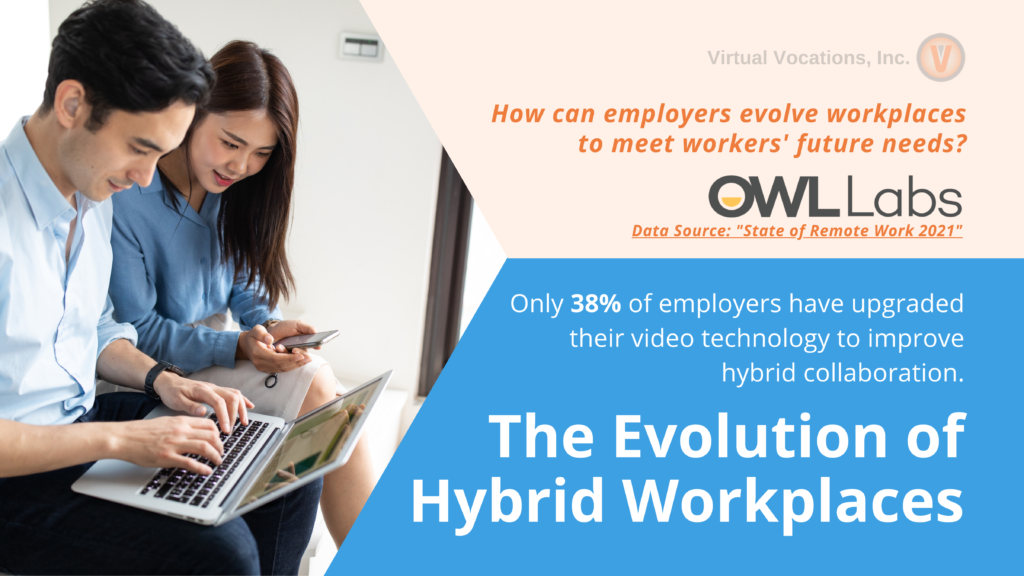
The Evolution of Hybrid Workplaces
In this new era of work, if a space isn’t wired for hybrid collaboration, it’s now a wasted space. It’s really that simple.
Owl Labs, State of Remote Work 2021
Companies must evolve to meet the needs of their employees. And the COVID-19 pandemic proved how quickly those needs can change. Since the start of the pandemic, “40% of employers provided a one-time payment to employees for work from home expenses.” Simultaneously, 35% of employers issued monthly remote work stipends, according to Owl Labs’ survey.
Video conferencing also proved an essential component to the formula for a successful remote workplace experience during the pandemic. Employee opinions on its effectiveness, however, were mixed.
- 72% of employees claimed that during video calls it is difficult to discern who is speaking at a given time.
- 70% said it is nearly always a challenge to be part of the conversation.
- 63% complained of not being able to see colleagues’ faces during video conferences.
- 62% could not see presentation whiteboards.
Despite nearly three-quarters of employees preferring video as a presentation method, employers have miles to go before technology standards are on par with the increased demand for remote and hybrid work in the 2020s. Owl Labs found that “To date, only 38% of employers have upgraded their video technology to improve hybrid collaboration.”
Video meetings can be a blessing or a burden to remote teams, depending on whether or not they add value to business operations. Get tips for approving the quality of Zoom meetings in this Virtual Vocations blog guest post featuring “7 Tips for Productive Zoom Calls.”
The permanent state of remote work is evident in data from Owl Labs and Virtual Vocations. Looking to the future of work in a post-pandemic society and economy, employees will drive decisions and conversations. The Great Resignation of 2021 is a clear sign that employees are keenly aware of their value. COVID-19’s sudden, forced changes to life and work for the U.S. labor force have spurned new motivations for employees to take hold of their career reins and reset their priorities.
Employees have expectations and employers need to do their utmost to meet them. That is, if companies want to remain competitive within a modern labor market that, at least for the foreseeable future, will continue to be candidate-driven. While no analysis can act as a crystal ball to fully predict the future of work, one thing is certain: remote work will be a permanent fixture of the U.S. labor force.
About Virtual Vocations

Virtual Vocations, Inc., founded in 2007, is a private, family-owned, and 100% distributed company. Co-founded by CEO Laura Spawn and her brother, CTO Adam Stevenson, Virtual Vocations is dedicated to connecting jobseekers with legitimate remote job openings that have been screened to ensure the highest quality standards. To date, Virtual Vocations has helped more than four million jobseekers find flexible, remote work options.
In addition to managing and curating a database that, at any given time, houses more than 30,000 current, hand-screened remote job openings, Virtual Vocations offers jobseekers a number of tools to aid in their job searches, including exclusive, self-paced e-courses, career guides for popular virtual job industries, downloadable worksheets, job coaching, and resume and cover letter writing services. Virtual Vocations also releases multiple data-driven reports each year on current trends in remote work.
Download a copy of “The Permanent State of Remote Work” report infographic.
Inquiries about “The Permanent State of Remote Work: Data & Analysis” can be made to Michelle Rawlings, Public Relations Specialist, at michelle (at) virtualvocations (dot) com or via phone at 1-800-379-5092, ext. 703. Please visit Virtual Vocations on Facebook, Twitter, LinkedIn, YouTube, Instagram, and Pinterest for additional remote work content and conversations.
Image credits: Kimberly Back; Canva






